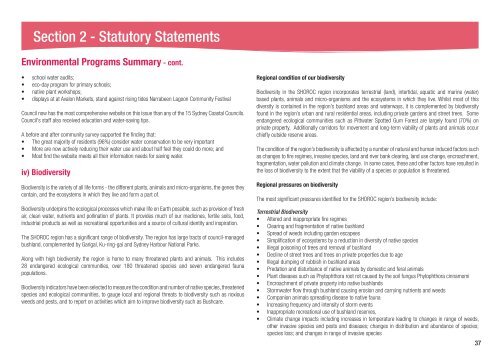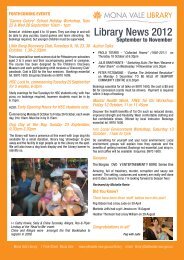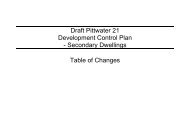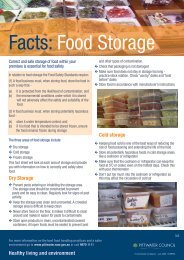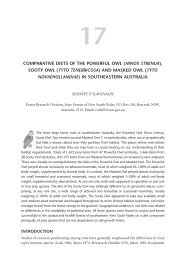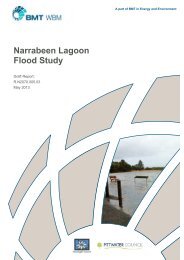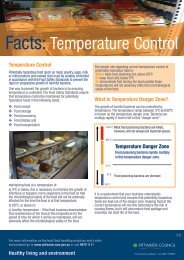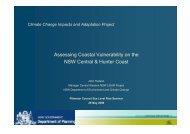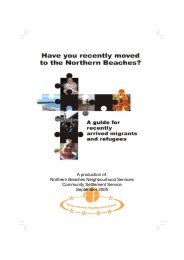Pittwater Council Annual Report - Pittwater Council - NSW ...
Pittwater Council Annual Report - Pittwater Council - NSW ...
Pittwater Council Annual Report - Pittwater Council - NSW ...
- No tags were found...
Create successful ePaper yourself
Turn your PDF publications into a flip-book with our unique Google optimized e-Paper software.
Section 2 - Statutory StatementsEnvironmental Programs Summary - cont.• school water audits;• eco-day program for primary schools;• native plant workshops;• displays at at Avalon Markets, stand against rising tides Narrabeen Lagoon Community Festival<strong>Council</strong> now has the most comprehensive website on this issue than any of the 15 Sydney Coastal <strong>Council</strong>s.<strong>Council</strong>'s staff also received education and water-saving tips.A before and after community survey supported the finding that:• The great majority of residents (96%) consider water conservation to be very important• More are now actively reducing their water use and about half feel they could do more; and• Most find the website meets all their information needs for saving water.iv) BiodiversityBiodiversity is the variety of all life forms - the different plants, animals and micro-organisms, the genes theycontain, and the ecosystems in which they live and form a part of.Biodiversity underpins the ecological processes which make life on Earth possible, such as provision of freshair, clean water, nutrients and pollination of plants. It provides much of our medicines, fertile soils, food,industrial products as well as recreational opportunities and a source of cultural identity and inspiration.The SHOROC region has a significant range of biodiversity. The region has large tracts of council-managedbushland, complemented by Garigal, Ku-ring-gai and Sydney Harbour National Parks.Along with high biodiversity the region is home to many threatened plants and animals. This includes28 endangered ecological communities, over 180 threatened species and seven endangered faunapopulations.Biodiversity indicators have been selected to measure the condition and number of native species, threatenedspecies and ecological communities, to gauge local and regional threats to biodiversity such as noxiousweeds and pests, and to report on activities which aim to improve biodiversity such as Bushcare.Regional condition of our biodiversityBiodiversity in the SHOROC region incorporates terrestrial (land), intertidal, aquatic and marine (water)based plants, animals and micro-organisms and the ecosystems in which they live. Whilst most of thisdiversity is contained in the region’s bushland areas and waterways, it is complemented by biodiversityfound in the region’s urban and rural residential areas, including private gardens and street trees. Someendangered ecological communities such as <strong>Pittwater</strong> Spotted Gum Forest are largely found (70%) onprivate property. Additionally corridors for movement and long-term viability of plants and animals occurchiefly outside reserve areas.The condition of the region’s biodiversity is affected by a number of natural and human induced factors suchas changes to fire regimes, invasive species, land and river bank clearing, land use change, encroachment,fragmentation, water pollution and climate change. In some cases, these and other factors have resulted inthe loss of biodiversity to the extent that the viability of a species or population is threatened.Regional pressures on biodiversityThe most significant pressures identified for the SHOROC region’s biodiversity include:Terrestrial Biodiversity• Altered and inappropriate fire regimes• Clearing and fragmentation of native bushland• Spread of weeds including garden escapees• Simplification of ecosystems by a reduction in diversity of native species• Illegal poisoning of trees and removal of bushland• Decline of street trees and trees on private properties due to age• Illegal dumping of rubbish in bushland areas• Predation and disturbance of native animals by domestic and feral animals• Plant diseases such as Phytophthora root rot caused by the soil fungus Phytophthora cinnamomi• Encroachment of private property into native bushlands• Stormwater flow through bushland causing erosion and carrying nutrients and weeds• Companion animals spreading disease to native fauna• Increasing frequency and intensity of storm events• Inappropriate recreational use of bushland reserves,• Climate change impacts including increases in temperature leading to changes in range of weeds,other invasive species and pests and diseases; changes in distribution and abundance of species;species loss; and changes in range of invasive species37


